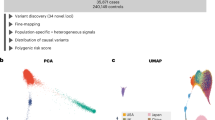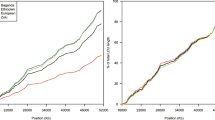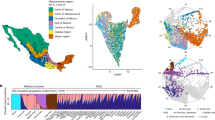Abstract
The sequencing of the human genome and the intense study of its variation in different human populations have improved our understanding of the genome's architecture. It is now becoming clear that segments of the genome that are unbroken by reshuffling or recombination during meiosis create a mosaic of DNA 'haplotype blocks'. Here, we discuss the advantages and limitations of this block structure. Haplotype blocks hold the promise of reducing the complexity of analysing the human genome for association with disease. But can they deliver on this promise? First generation maps of these block patterns, such as the admixture and haplotype maps, are now emerging and, it is to be hoped, will accelerate the discovery of alleles that contribute to susceptibility to human inflammatory diseases.
This is a preview of subscription content, access via your institution
Access options
Subscribe to this journal
Receive 12 print issues and online access
$209.00 per year
only $17.42 per issue
Buy this article
- Purchase on Springer Link
- Instant access to full article PDF
Prices may be subject to local taxes which are calculated during checkout


Similar content being viewed by others
References
Risch, N. J. Searching for genetic determinants in the new millennium. Nature 405, 847–856 (2000).
The International HapMap Consortium. The International HapMap Project. Nature 426, 789–796 (2003).
Abecasis, G. R. et al. Extent and distribution of linkage disequilibrium in three genomic regions. Am. J. Hum. Genet. 68, 191–197 (2001).
Smith, M. W. et al. A high-density admixture map for disease gene discovery in African Americans. Am. J. Hum. Genet. 74, 1001–1013 (2004).
Botstein, D. & Risch, N. Discovering genotypes underlying human phenotypes: past successes for mendelian disease, future approaches for complex disease. Nature Genet. 33 (Suppl.), 228–237 (2003).
Kurtzke, J. F., Beebe, G. W. & Norman, J. E.. Epidemiology of multiple sclerosis in U.S. veterans: 1. Race, sex, and geographic distribution. Neurology 29, 1228–1235 (1979).
Fessel, W. J. Systemic lupus erythematosus in the community. Incidence, prevalence, outcome, and first symptoms; the high prevalence in black women. Arch. Intern. Med. 134, 1027–1035 (1974).
Hopkinson, N. D., Doherty, M. & Powell, R. J. Clinical features and race-specific incidence/prevalence rates of systemic lupus erythematosus in a geographically complete cohort of patients. Ann. Rheum. Dis. 53, 675–680 (1994).
Johnson, A. E., Gordon, C., Palmer, R. G. & Bacon, P. A. The prevalence and incidence of systemic lupus erythematosus in Birmingham, England. Relationship to ethnicity and country of birth. Arthritis Rheum. 38, 551–558 (1995).
Nossent, J. C. Systemic lupus erythematosus on the Caribbean island of Curacao: an epidemiological investigation. Ann. Rheum. Dis. 51, 1197–1201 (1992).
Molokhia, M. et al. Relation of risk of systemic lupus erythematosus to west African admixture in a Caribbean population. Hum. Genet. 112, 310–318 (2003).
Bonilla, C., Shriver, M. D., Parra, E. J., Jones, A. & Fernandez, J. R. Ancestral proportions and their association with skin pigmentation and bone mineral density in Puerto Rican women from New York city. Hum. Genet. 115, 57–68 (2004).
Chakraborty, R. & Weiss, K. M. Admixture as a tool for finding linked genes and detecting that difference from allelic association between loci. Proc. Natl Acad. Sci. USA 85, 9119–9123 (1988).
Sachidanandam, R. et al. A map of human genome sequence variation containing 1.42 million single nucleotide polymorphisms. Nature 409, 928–933 (2001).
Patterson, N. et al. Methods for high-density admixture mapping of disease genes. Am. J. Hum. Genet. 74, 979–1000 (2004).
Hoggart, C. J., Shriver, M. D., Kittles, R. A., Clayton, D. G. & McKeigue, P. M. Design and analysis of admixture mapping studies. Am. J. Hum. Genet. 74, 965–978 (2004).
Wang, J. Maximum-likelihood estimation of admixture proportions from genetic data. Genetics 164, 747–765 (2003).
Zhu, X., Cooper, R. S. & Elston, R. C. Linkage analysis of a complex disease through use of admixed populations. Am. J. Hum. Genet. 74, 1136–1153 (2004).
Gabriel, S. B. et al. The structure of haplotype blocks in the human genome. Science 296, 2225–2229 (2002).
Ardlie, K. G., Lunetta, K. L. & Seielstad, M. Testing for population subdivision and association in four case–control studies. Am. J. Hum. Genet. 71, 304–311 (2002).
Freedman, M. L. et al. Assessing the impact of population stratification on genetic association studies. Nature Genet. 36, 388–393 (2004).
Reich, D. E. & Goldstein, D. B. Detecting association in a case–control study while correcting for population stratification. Genet. Epidemiol. 20, 4–16 (2001).
Siddiqui, A. et al. Association of multidrug resistance in epilepsy with a polymorphism in the drug-transporter gene ABCB1. N. Engl. J. Med. 348, 1442–1448 (2003).
Yunis, E. J. et al. Inheritable variable sizes of DNA stretches in the human MHC: conserved extended haplotypes and their fragments or blocks. Tissue Antigens 62, 1–20 (2003).
Jersild, C. et al. Histocompatibility-linked immune-response determinants in multiple sclerosis. Transplant Proc. 5, 1791–1796 (1973).
Allcock, R. J. et al. The MHC haplotype project: a resource for HLA-linked association studies. Tissue Antigens 59, 520–521 (2002).
Rioux, J. D. et al. Genomewide search in Canadian families with inflammatory bowel disease reveals two novel susceptibility loci. Am. J. Hum. Genet. 66, 1863–1870 (2000).
Daly, M. J. & Rioux, J. D. New approaches to gene hunting in IBD. Inflamm. Bowel Dis. 10, 312–317 (2004).
Johnson, G. C. et al. Haplotype tagging for the identification of common disease genes. Nature Genet. 29, 233–237 (2001).
Patil, N. et al. Blocks of limited haplotype diversity revealed by high-resolution scanning of human chromosome 21. Science 294, 1719–1723 (2001).
Daly, M. J., Rioux, J. D., Schaffner, S. F., Hudson, T. J. & Lander, E. S. High-resolution haplotype structure in the human genome. Nature Genet. 29, 229–232 (2001).
Dawson, E. et al. A first-generation linkage disequilibrium map of human chromosome 22. Nature 418, 544–548 (2002).
Osier, M. V. et al. A global perspective on genetic variation at the ADH genes reveals unusual patterns of linkage disequilibrium and diversity. Am. J. Hum. Genet. 71, 84–99 (2002).
Wall, J. D. & Pritchard, J. K. Haplotype blocks and linkage disequilibrium in the human genome. Nature Rev. Genet. 4, 587–597 (2003).
Florez, J. C. et al. Haplotype structure and genotype–phenotype correlations of the sulfonylurea receptor and the islet ATP-sensitive potassium channel gene region. Diabetes 53, 1360–1368 (2004).
Wall, J. D. & Pritchard, J. K. Assessing the performance of the haplotype block model of linkage disequilibrium. Am. J. Hum. Genet. 73, 502–515 (2003).
Wang, N., Akey, J. M., Zhang, K., Chakraborty, R. & Jin, L. Distribution of recombination crossovers and the origin of haplotype blocks: the interplay of population history, recombination, and mutation. Am. J. Hum. Genet. 71, 1227–1234 (2002).
Phillips, M. S. et al. Chromosome-wide distribution of haplotype blocks and the role of recombination hot spots. Nature Genet. 33, 382–387 (2003).
Zhang, K. et al. Randomly distributed crossovers may generate block-like patterns of linkage disequilibrium: an act of genetic drift. Hum. Genet. 113, 51–59 (2003).
Pe'er, I. & Beckmann, J. S. On the applicability of a haplotype map to un-assayed populations. Hum. Genet. 114, 214–217 (2004).
Carlson, C. S. et al. Additional SNPs and linkage-disequilibrium analyses are necessary for whole-genome association studies in humans. Nature Genet. 33, 518–521 (2003).
Crawford, D. C. et al. Haplotype diversity across 100 candidate genes for inflammation, lipid metabolism, and blood pressure regulation in two populations. Am. J. Hum. Genet. 74, 610–622 (2004).
Reich, D. E. et al. Linkage disequilibrium in the human genome. Nature 411, 199–204 (2001).
Zhang, K., Deng, M., Chen, T., Waterman, M. S. & Sun, F. A dynamic programming algorithm for haplotype block partitioning. Proc. Natl Acad. Sci. USA 99, 7335–7339 (2002).
Anderson, E. C. & Novembre, J. Finding haplotype block boundaries by using the minimum-description-length principle. Am. J. Hum. Genet. 73, 336–354 (2003).
Cardon, L. R. & Abecasis, G. R. Using haplotype blocks to map human complex trait loci. Trends Genet. 19, 135–140 (2003).
Stumpf, M. P. & Goldstein, D. B. Demography, recombination hotspot intensity, and the block structure of linkage disequilibrium. Curr. Biol. 13, 1–8 (2003).
Clark, A. G. Finding genes underlying risk of complex disease by linkage disequilibrium mapping. Curr. Opin. Genet. Dev. 13, 296–302 (2003).
Tishkoff, S. A. & Verrelli, B. C. Role of evolutionary history on haplotype block structure in the human genome: implications for disease mapping. Curr. Opin. Genet. Dev. 13, 569–575 (2003).
Carlson, C. S. et al. Selecting a maximally informative set of single-nucleotide polymorphisms for association analyses using linkage disequilibrium. Am. J. Hum. Genet. 74, 106–120 (2004).
Deloukas, P. & Bentley, D. The HapMap Project and its application to genetic studies of drug response. Pharmacogenomics J. 4, 88–90 (2004).
Taillon-Miller, P. et al. Linkage disequilibrium maps constructed with common SNPs are useful for first-pass disease association screens. Genomics 84, 899–912 (2004).
van den Oord, E. J. & Neale, B. M. Will haplotype maps be useful for finding genes? Mol. Psychiatry 9, 227–236 (2004).
Goldstein, D. B., Ahmadi, K. R., Weale, M. E. & Wood, N. W. Genome scans and candidate gene approaches in the study of common diseases and variable drug responses. Trends Genet. 19, 615–622 (2003).
Mitra, N. et al. Localization of cancer susceptibility genes by genome-wide single-nucleotide polymorphism linkage-disequilibrium mapping. Cancer Res. 64, 8116–8125 (2004).
Maron, R. et al. Genetic susceptibility or resistance to autoimmune encephalomyelitis in MHC congenic mice is associated with differential production of pro- and anti-inflammatory cytokines. Int. Immunol. 11, 1573–1580 (1999).
Greve, B. et al. The diabetes susceptibility locus Idd5.1 on mouse chromosome 1 regulates ICOS expression and modulates murine experimental autoimmune encephalomyelitis. J. Immunol. 173, 157–163 (2004).
Jeffreys, A. J., Kauppi, L. & Neumann, R. Intensely punctate meiotic recombination in the class II region of the major histocompatibility complex. Nature Genet. 29, 217–222 (2001).
Walsh, E. C. et al. An integrated haplotype map of the human major histocompatibility complex. Am. J. Hum. Genet. 73, 580–590 (2003).
Sawcer, S. J. et al. Enhancing linkage analysis of complex disorders: an evaluation of high-density genotyping. Hum. Mol. Genet. 13, 1943–1949 (2004).
Author information
Authors and Affiliations
Corresponding author
Ethics declarations
Competing interests
The authors declare no competing financial interests.
Related links
Related links
DATABASES
Entrez Gene
OMIM
FURTHER INFORMATION
Glossary
- ADMIXTURE
-
The mixing of two genetically distinct populations.
- ASSOCIATION STUDIES
-
An approach to gene mapping that looks for associations between a particular disease phenotype and allelic variation.
- RANDOM GENETIC DRIFT
-
The random fluctuation in population allele frequencies as genes are transmitted from one generation to the next.
- SINGLE-NUCLEOTIDE POLYMORPHISMS
-
(SNPs). Bi-allelic (typically) base-pair substitutions, which are the most common forms of genetic polymorphism.
Rights and permissions
About this article
Cite this article
Hafler, D., Jager, P. Applying a new generation of genetic maps to understand human inflammatory disease. Nat Rev Immunol 5, 83–91 (2005). https://doi.org/10.1038/nri1532
Issue Date:
DOI: https://doi.org/10.1038/nri1532
This article is cited by
-
Multiple sclerosis: getting personal with induced pluripotent stem cells
Cell Death & Disease (2015)
-
Linkage disequilibrium and haplotype blocks in the MHC vary in an HLA haplotype specific manner assessed mainly by DRB1*03 and DRB1*04 haplotypes
Genes & Immunity (2006)
-
High resolution linkage disequilibrium and haplotype maps for the genes in the centromeric region of chromosome 15 in Tibetans and comparisons with Han population
Chinese Science Bulletin (2006)
-
Possible relations between the polymorphisms of the cytokines IL-19, IL-20 and IL-24 and plaque-type psoriasis
Genes & Immunity (2005)



